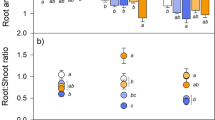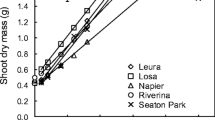Abstract
Background and aims
Incorporating soybean (Glycine max) genotypes with a high nitrogen fixation potential into cropping systems can sustainably improve the livelihoods of smallholder farmers in Western Kenya. Nitrogen fixation is, however, often constrained by low phosphorus (P) availability. The selection of soybean genotypes for increased P efficiency could help to overcome this problem. This study investigated the contribution of different root traits to variation in P efficiency among soybean genotypes.
Methods
Eight genotypes were grown in a Ferralsol amended with suboptimal (low P) and optimal (high P) amounts of soluble P. Root hair growth was visualized by growing plants in a novel agar system where P intensity was buffered by Al2O3 nanoparticles.
Results
In the pot trial, P uptake was unaffected among the genotypes at high P but differed about 2-fold at low P. The genotypes differed in P uptake efficiency but not in P utilization efficiency. Regression analysis and mechanistic modeling indicated that P uptake efficiencies were to a large extent related to root hair development (length and density) and, to a lower extent, to colonization by mycorrhizal fungi.
Conclusion
Breeding for improved root hair development is a promising way to increase P uptake efficiency in soybean.







Similar content being viewed by others
Abbreviations
- AMF:
-
Arbuscular mycorrhizal fungi
- DAP:
-
Days after planting
- IITA:
-
International Institute of Tropical Agriculture
- MP:
-
Maturity period
- TSBF-CIAT:
-
Tropical Soil Biology and Fertility Institute of the International Center for Tropical Agriculture
References
Barber SA (1984) Soil nutrient bioavailability. John Wiley & Sons Inc, New York
Barraclough PB, Tinker PB (1981) The determination of ionic diffusion coefficients in field soils I. Diffusion coefficients in sieved soils in relation to water content and bulk density. J Soil Sci 32:225–236
Bates TR, Lynch JP (1996) Stimulation of root hair elongation in Arabidopsis thaliana by low phosphorus availability. Plant Soil 19:529–538
Bonser AM, Lynch J, Snapp S (1996) Effect of phosphorus deficiency on growth angle of basal roots in Phaseolus vulgaris. New Phytol 132:281–288
Brundrett MC, Piche Y, Peterson RL (1984) A new method for observing the morphology of vesicular-arbuscular mycorrhizae. Can J Bot 62:2128–2134
Cardoso IM, Kuyper TW (2006) Mycorrhizas and tropical soil fertility. Agric Ecosyst Environ 116:72–84
Chhabra R, Pleysier J, Cremers A (1975) The measurement of cation exchange capacity and exchangeable cations in soil: a new method. In: Proceedings of the International Clay Conference. Applied publishing Ltd., Wilmette, Illinions, pp 433–499
Claassen N (1990) Nährstoffaufname höherer Pflanzen aus dem Boden als Ergebnis von Verfügbarkeit und Aneignungsvermögen. Severin-Verlag, Göttingen
Claassen N, Steingrobe B (1999) Mechanistic simulation models for a better understanding of nutrient uptake from soil. In: Rengel Z, Binghamto NY (ed) Mineral Nutrition of Crops: Fundamental Mechanisms and Implications. The Haworth Press, Inc, pp 327–367
Day P (1965) Particle fractioning and particle size analysis. In: Black C et al (eds) Methods of Soil Analysis, Part 1. ASA, Madison, pp 545–562
Dechassa N, Schenk MK, Claassen N, Steingrobe B (2003) Phosphorus Efficiency of Cabbage (Brassica oleraceae L. var. capitata), Carrot (Daucus carota L.), and Potato (Solanum tuberosum L.). Plant Soil 250:215–224
Edwards OW, Huffman EO (1959) Diffusion of aqueous solutions of phosphoric acid at 25°C. J Phys Chem 63:1830–1833
FAO-ISRIC-ISSS (1998) World reference base for soil resources. World Soil Resources Report 84. FAO, Rome
Fernández MC, Belinque H, Boem FHG, Rubio G (2009) Compared Phosphorus Efficiency in soybean, sunflower and maize. J Plant Nutr 32:2027–2043
Föhse D, Jungk A (1983) Influence of phosphate and nitrate supply on root hair formation of rape, spinach and tomato plants. Plant Soil 74:359–368
Föhse D, Claassen N, Jungk A (1988) Phosphorus efficiency of plants. I, External and internal P requirement and P uptake efficiency of different plant species. Plant Soil 110:101–109
Föhse D, Claassen N, Jungk A (1991) Phosphorus efficiency of plants. II, Significance of root radius, root hairs and cation-anion balance for phosphorus influx in seven plant species. Plant Soil 132:261–272
Forde B, Lorenzo H (2001) The nutritional control of root development. Plant Soil 232:51–68
Gahoonia TS, Nielsen NE (1998) Direct evidence on participation of root hairs in phosphorus (32P) uptake from soil. Plant Soil 198:147–152
Gahoonia TS, Nielsen NE (2004a) Barley genotypes with long root hairs sustain high grain yields in low-P field. Plant Soil 262:55–62
Gahoonia TS, Nielsen NE (2004b) Root traits as tools for creating phosphorus efficient crop varieties. Plant Soil 260:47–57
Gahoonia TS, Care D, Nielsen NE (1997) Root hairs and phosphorus acquisition of wheat and barley cultivars. Plant Soil 191:181–188
Gahoonia TS, Nielsen NE, Lyshede OB (1999) Phosphorus (P) acquisition of cereal cultivars in the field at three levels of P fertilization. Plant Soil 211:269–281
Itoh S, Barber SA (1983) Phosphorus uptake by six plant species as related to root hairs. Agron J 75:457–461
Jungk A, Asher CJ, Edwards DG, Meyer D (1990) Influence of phosphate status on phosphate uptake kinetics of maize (Zea mays) and soybean (Glycine max). Plant Soil 124:175–182
Kirk GJD (2002) Use of modelling to understand nutrient acquisition by plants. Plant Soil 247:123–130
Lambers H, Shane MW, Cramer MD, Pearse SJ, Veneklaas EJ (2006) Root structure and functioning for efficient acquisition of phosphorus: matching morphological and physiological traits. Ann Bot 98:693–713
Lynch JP (2007) Roots of the Second Green Revolution. Aust J Bot 55:493–512
Nwoko H, Sanginga N (1999) Dependence of promiscuous soybean and herbaceous legumes on arbuscular mycorrhizal fungi and their response to bradyrhizobial inoculation in low P soils. Appl Soil Ecol 13:251–258
Nye PH, Mariott FC (1969) A theoretical study of the distribution of substances around roots resulting from simultaneous diffusion and mass flow. Plant Soil 30:459–472
Osborne L, Rengel Z (2002) Screening cereals for genotypic variation in efficiency of phosphorus uptake and utilisation. Aust J Agr Res 53:295–303
Ozanne PG, Shaw TC (1968) Advantages of the recently developed phosphate sorption test over older extractant methods for soil phosphate. Trans 9th Int Congr. Soil Sci 2:273–280
Pan X, Li W, Zhang Q, Li Y, Liu M (2008) Assessment on Phosphorus Efficiency Characteristics of Soybean Genotypes in Phosphorus-Deficient Soils. Agr Sci China:958–969
Pang J, Ryan MH, Tibbett M, Cawthray GR, Siddique KHM, Bolland MDA, Denton MD, Lambers H (2010) Variation in morphological and physiological parameters in herbaceous perennial legumes in response to phosphorus supply. Plant Soil 331:241–255
Phillips JM, Hayman DS (1970) Improved procedure for cleaning roots and staining parasitic and Vesicular-arbuscular mycorrhizal fungi for rapid assessment of infection. Trans Brit Mycol Soc 5:158–161
Pypers P (2006) Isotopic approaches to characterize P availability and P acquisition by maize and legumes in highly weathered soils. PhD dissertation, Katholieke Universiteit Leuven
Ramaekers L, Remans R, Rao IM, Blair MW, Vanderleyden J (2010) Strategies for improving phosphorus acquisition efficiency of crop plants. Field Crop Res 117:169–176
Rao IM, Borrero V, Ricaurte J, Garcia R, Ayarza MA (1996) Adaptive attributes of tropical forage species to acid soils. II. Differences in shoot and root growth responses to varying phosphorus supply and soil type. J Plant Nutr 19:323–352
Rao IM, Borrero V, Ricaurte J, Garcia R, Ayarza MA (1997) Adaptive attributes of tropical forage species to acid soils. III. Differences in phosphorus acquisition and utilization as influenced by varying phosphorus supply and soil type. J Plant Nutr 20:155–180
Sanginga N (2003) Role of biological nitrogen fixation in legume based cropping systems; a case study of West Africa farming systems. Plant Soil 252:25–39
Sanginga N, Okogun JA, Akobundu IO, Kang BT (1996) Phosphorus requirement and nodulation of herbaceous and shrub legumes in low P soils of a Guinean savanna in Nigeria. Appl Soil Ecol 3:247–255
Santner J, Smolders E, Wenzel W, Degryse F (2012) First observation of diffusion-limited plant root phosphorus uptake from nutrient. Plant Cell Environ 35:1558–1566
SAS Institute Inc (2012) SAS/STAT 9.3 User’s Guide, 2nd edn. SAS Institute Inc, Cary
Schroeder MS, Janos DP (2005) Plant growth, phosphorus nutrition, and root morphological responses to arbuscular mycorrhizas, phosphorus fertilization, and intraspecific density. Mycorrhiza 15:203–216
Schwertmann U (1964) Differenzierung der eisen-oxide des bodens durch photochemische extraktion mit sauer ammonium oxalat-lösung. Z Pflanz Bodenkunde 105:194–202
Sibbesen E (1983) Phosphate soil tests and their suitability to assess the phosphate status of the soil. J Sci Food Agric 34:1368–1974
Smith SE, Jakobsen I, Grønlund M, Smith FA (2011) Roles of arbuscular mycorrhizas in plant phosphorus nutrition: interactions between pathways of phosphorus uptake in arbuscular mycorrhizal roots have important implications for understanding and manipulating plant phosphorus acquisition. Plant Physiol 156:1050–1057
Van Veldhoven PP, Mannaerts GP (1987) Inorganic and organic phosphate measurements in the nanomolar range. Anal Biochem 161:45–48
Vanlauwe B, Bationo A, Chianu J, Giller KE, Merckx R, Mokwunye U, Ohiokpehai O, Pypers P, Tabo R, Shepherd KD, Smaling EMA, Woomer PL, Sanginga N (2010) Integrated soil fertility management. Operational definition and consequences for implementation and dissemination. Outlook Agr 39:17–24
Wang L, Liao H, Yan X, Zhuang B, Dong Y (2004) Genetic variability for root hair traits as related to phosphorus status in soybean. Plant Soil 261:77–84
Wang X, Yan X, Liao H (2010) Genetic improvement for phosphorus efficiency in soybean: a radical approach. Ann Bot 106:215–222
Williams RF (1948) The effect of phosphorus supply on the rates of intake of phosphorus and nitrogen upon certain aspects of phosphorus metabolism in gramineous plants. Austr J Biol Sci 1:333–361
Wissuwa M (2003) How do plants achieve tolerance to phosphorus deficiency? Small causes with Big effects. Plant Physiol 133:1947–1958
Yan X, Liao H, Beebe SE, Blair MW, Lynch JP (2004) QTL mapping of root hair and acid exudation traits and their relationship to phosphorus uptake in common bean. Plant Soil 265:17–29
Zahran HH (1999) Rhizobium-legume symbiosis and nitrogen fixation under severe conditions and in an arid climate. Microbiol Mol Biol R 63:968–989
Acknowledgments
The authors wish to thank Philip Malala, Magdalene Mutia and Purity Nduku for their valuable help during greenhouse work and Nyawira Lukey for carrying out analyses on mycorrhizal colonization. We are also grateful to the team of the TSBF-CIAT Maseno for their assistance with soil sampling, and to Jan Diels for his expert advice on statistical analysis. Marian Renkens acknowledges a travel grant from the University Development Cooperation of the Flemish Interuniversity Council (VLIR-UDC). Elke Vandamme acknowledges a VLIR-UDC PhD scholarship.
Author information
Authors and Affiliations
Corresponding author
Additional information
Responsible Editor: Tim Simon George.
Rights and permissions
About this article
Cite this article
Vandamme, E., Renkens, M., Pypers, P. et al. Root hairs explain P uptake efficiency of soybean genotypes grown in a P-deficient Ferralsol. Plant Soil 369, 269–282 (2013). https://doi.org/10.1007/s11104-012-1571-2
Received:
Accepted:
Published:
Issue Date:
DOI: https://doi.org/10.1007/s11104-012-1571-2




